Some of the most dangerous animals in Georgia are potentially deadly when they come in contact with humans, and measures should be taken to guard against them. These animals include spiders, snakes, nasty insects, etc.
The state of Georgia is a fanciful spot for vacation, honeymoon, or any other trip.
Georgia is located in the southeastern parts of South Carolina, Florida, Tennessee, and North Carolina.
It is the 8th most populous state in the world, and there’s a variety of plants and animals that you can explore.
However, there are things to consider with the wildlife in the area.
We’ll walk through 15 of the most dangerous animals that live in Georgia, as well as some measures to take so you can remain safe.
What are the Most Dangerous Animals in Georgia?
1. Fire Ant
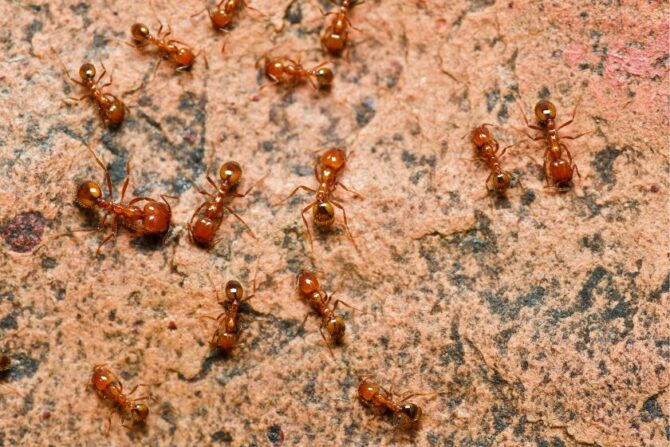
- Scientific name: Solenopsis
- Classification: Insects
- Habitat: Meadows, pastures, parks
- Diet: Omnivore
- Conservation status: Common
Fire ants are a group of ants that belong to the genus Solenopsis, and there are over 200 species of these insects.
They are characterized by their color and their stinging properties. This sting is what makes the fire ants dangerous.
A fire ant’s sting is venomous, and though it is not fatal, you’d experience pain that feels like a burning sensation. It also causes urticaria and can leave you in an uncomfortable situation for days.
Allergic people would have more problems—like anaphylaxis—and need urgent medical attention.
2. Brown Recluse Spider

- Scientific name: Loxosceles reclusa
- Classification: Arachnid
- Habitat: Woodpiles, debris
- Diet: Carnivore
- Conservation status: Not extinct
The brown recluse is one of many recluse spider species, and characteristic of all these spiders, the brown recluse is a solitary animal that avoids human contact as much as possible.
What makes it dangerous, then? The answer lies in its venom.
The brown recluse is amongst the three spiders in North America whose venom has a significant effect.
The other spiders are the Chilean recluse and the black widow, the latter being a part of this list.
The brown recluse venom isn’t fatal and bites are rare, but you should ensure that there are no brown recluse spiders in your environment.
Related:
Brown Recluse Vs Wolf Spider: 7 Differences & Facts
3. Bobcats
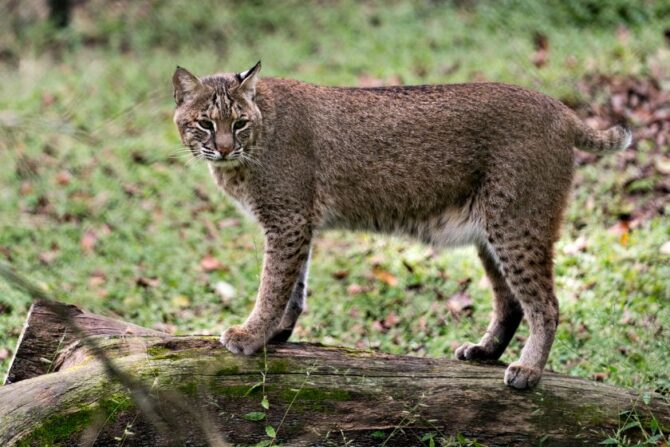
- Scientific name: Lynx rufus
- Classification: Mammal
- Habitat: Forests, swamps, deserts, scrublands
- Diet: Carnivore
- Conservation status: Least Concern
The bobcat is also known as the red lynx, and it is majorly found in North America. Just as its name shows, the bobcat falls under the Felidae (cat) family.
It is a relative to your pet kitty, but you can’t turn the bobcat into a domesticated feline. It is a wild cat.
The bobcat is dangerous because of how easily they attack humans. If you have the ill luck of meeting a hungry bobcat, it might consider you as prey.
It gets worse when it’s rabid. That said, the bobcat hardly attacks people.
4. Eastern Coral Snake

- Scientific name: Micrurus fulvius
- Classification: Reptile
- Habitat: Oaks, slash pine, hammock
- Diet: Carnivore
- Conservation status: Least Concern
The eastern coral snake can be found only in the southeastern areas of the United States, and it also goes by the names common coral snakes and the American cobra.
The eastern coral snake looks like the scarlet snake and the scarlet king snake, which are not as dangerous.
The eastern coral snake is highly venomous, and the effects are serious.
The venom can cause paralysis, slurred speech, double vision, and even respiratory failure. This snake’s bite can be fatal.
5. Deer Tick

- Scientific name: Ixodes scapularis
- Classification: Arachnid
- Habitat: Tall grass, shrubs, brush
- Diet: Carnivore
- Conservation status: Not listed
The deer tick is also known as the black-legged tick, and it is one out of many other tick species in Georgia.
Ticks aren’t aggressive and do not appear dangerous, but they are carriers of some strong diseases, granting them a spot on this list.
A common disease often attributed to the tick is Lyme disease, which shows symptoms like rash, fatigue, muscle aches, headache, fever, sleep disturbance, and even difficulty concentrating.
Other diseases caused by the tick include babesiosis, Powassan virus disease, and anaplasmosis.
6. Eastern Copperhead

- Scientific name: Agkistrodon contortix
- Classification: Reptile
- Habitat: Deciduous forest, woodlands
- Diet: Carnivore
- Conservation status: Least Concern
The eastern copperhead is also known as the copperhead, and it can only be found in North America.
It is well recognized for its distinctive color pattern which combines both red and black to create a beautiful combination.
However, the eastern copperhead’s beauty only remains on the surface. This snake is highly venomous, and though death is rare, the effect of the venom can be severe.
The effects include swelling, extreme pain, and nausea. Fortunately, the eastern copperhead isn’t aggressive. It hardly attacks without cause.
7. Pigmy Rattlesnake
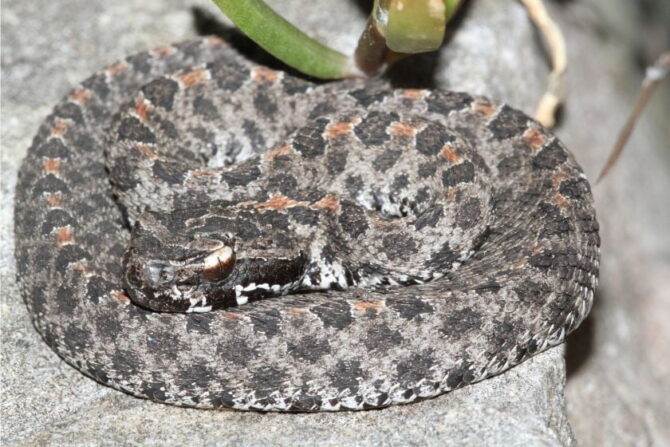
- Scientific name: Sistrutus miliarius
- Classification: Reptile
- Habitat: Mixed forests, marshes, lakes
- Diet: Carnivore
- Conservation status: Least Concern
The pigmy rattlesnake can be found only in the southeastern United States, and as the name goes, it is a small rattlesnake species.
It can stay in both a wet and dry environment, that’s why its habitat ranges from streams to forests.
Like other rattlesnakes, the pigmy rattlesnake is venomous, and the venom isn’t a mild one. It causes symptoms similar to that of other snakes we’ve seen, from paralysis to respiratory failure.
The venom doesn’t always kill, but it is deadly enough to be wary of.
8. Kissing Bug

- Scientific name: Triatominae
- Classification: Insects
- Habitat: Porches, rocks
- Diet: Sanguivore
- Conservation status: Not listed
The kissing bug is a subfamily of insects also known as the Triatominae.
They belong to the Reduviidae family, and they can also be known as conenose bugs or vampire bugs.
The kissing bug is mainly in the American continents, with a few found in continents like Africa and Asia.
Just like ticks, kissing bugs don’t seem dangerous. However, kissing bugs are known to bite people while they sleep.
The kissing bug’s bite is painless, but that doesn’t make it less potent. On the contrary, this insect transmits the Chagas disease, also known as American trypanosomiasis.
Symptoms include fatigue, vomiting, loss of appetite, and even an enlarged heart.
9. Southern Black Widow Spider
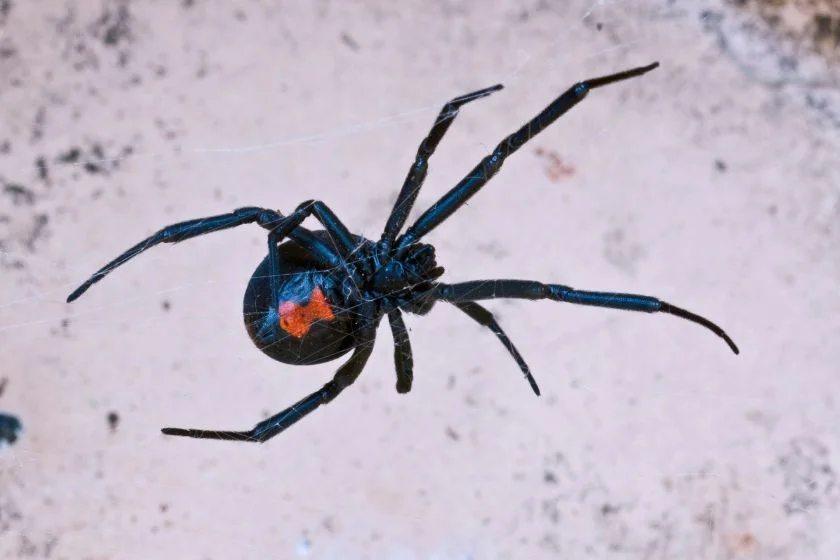
- Scientific name: Lactrodectus mactans
- Classification: Arachnid
- Habitat: Wood and rock piles, rodent burrows
- Diet: Carnivore
- Conservation status: Common
Remember what we said about the black widow spider under the brown recluse? It’s only fitting that this spider comes on our list.
There are many black widow spider species, but the most common in the United States is the southern black widow.
The southern black widow’s venom can cause pain but is hardly fatal for adults.
It has more effects on kids and elderly ones, so watch out for your grandparents and little ones!
10. Grizzly Bear

- Scientific name: Ursus arctos horribilis
- Classification: Mammal
- Habitat: Woodland, alpine meadows
- Diet: Carnivore
- Conservation status: Least Concern
The grizzly bear and black bear are both in Georgia. They are both dangerous, but the grizzly bear’s aggressiveness is a step further.
Thus, we picked the grizzly bear for our list. Simply known as the grizzly, this is a subspecies of the brown bear.
The grizzly bear is a fighter and stands its ground against a threat, even if the threat is an overenthusiastic tourist with a camera.
Mother grizzlies are more prone to aggression as they protect their cubs fiercely. Some attacks from these bears have been fatal.
11. Centipede

- Scientific name: Chilopoda
- Classification: Arthropod
- Habitat: Desert, tropics, seashore
- Diet: Carnivore
- Conservation status: Not extinct
The centipede belongs to the Chilopoda family, and they are widespread across different continents.
The centipede is considered one of the most dangerous animals you’ll meet in Georgia, regardless of its size. All centipedes are venomous, and they bite.
The centipede’s venom isn’t fatal to a healthy adult, but it can cause pain, blurred vision, an increase in blood pressure, and respiratory problems.
The venom can be washed off, but we recommend going for a checkup if you get bit, especially if you’re allergic.
12. Red Foxes
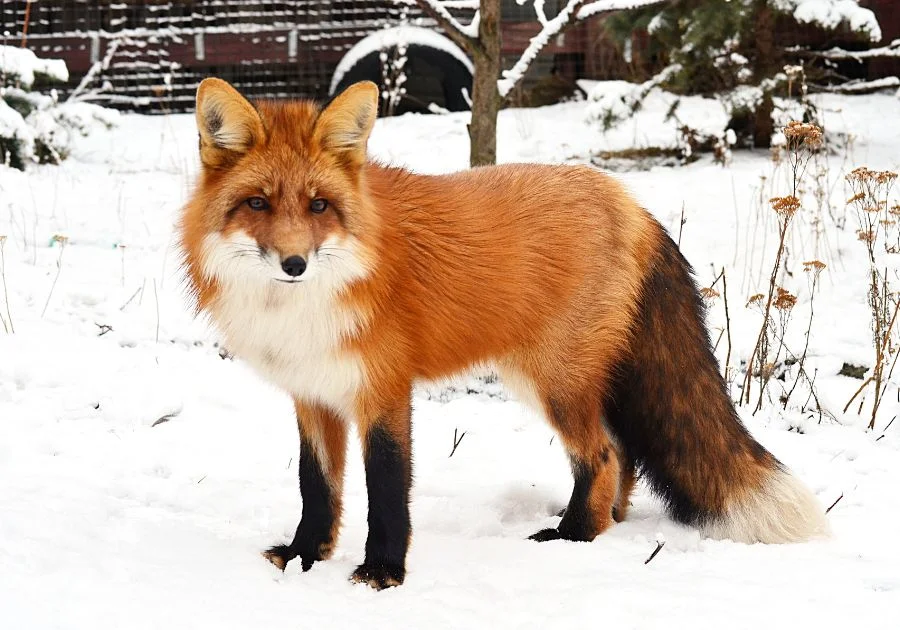
- Scientific name: Vulpes vulpes
- Classification: Mammal
- Habitat: Forest, fields, marshes
- Diet: Carnivore
- Conservation status: Least Concern
The red fox can be found on different continents, including North America, Europe, and North Africa.
It is so widespread that it is considered a very invasive species. The red fox has many subspecies, and it moves in pairs or small groups.
A solo red fox doesn’t pose too many challenges and may not attack, but when these foxes are grouped they are more likely to attack.
Their bites aren’t deadly, but you’d still need medical attention because the red fox can carry rabies. They also attack pets and kids.
13. Wolf Spider
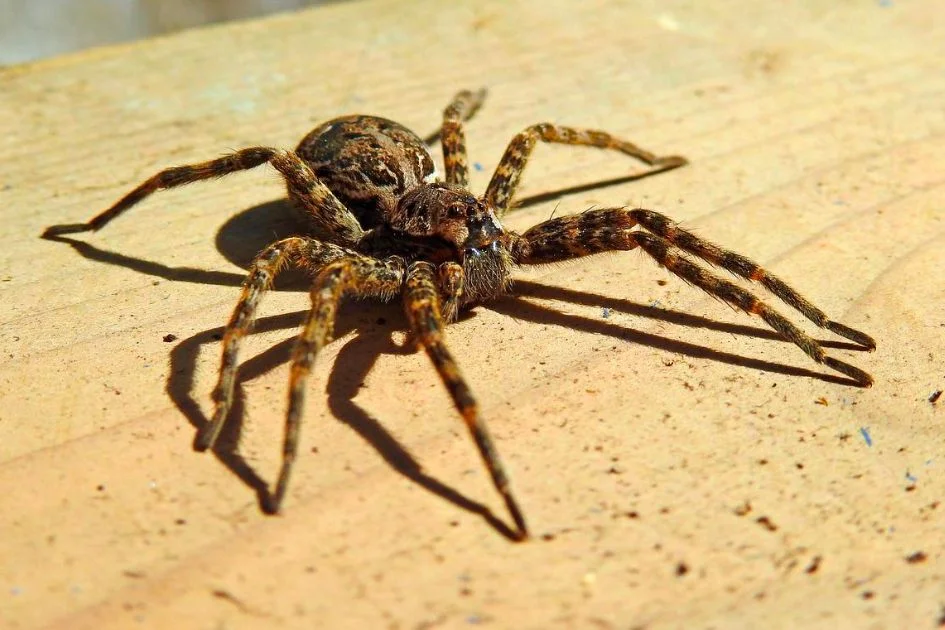
- Scientific name: Lycosidae
- Classification: Arachnids
- Habitat: Shrublands, woodland, alpine meadows
- Diet: Carnivore
- Conservation status: Not extinct
The wolf spider is any spider in the Lycosidae family, and these spiders are characterized by a lack of web-spinning ability.
They also have sharp eyesight, and they are good hunters. Rather than trap prey in webs, the wolf spider pursues them like other predators and pounces on them.
The main danger of the wolf spider is its venom. When provoked, it will react by biting, and it injects venom when it does so.
Symptoms include swelling, mild pain, and itching.
14. Timber Rattlesnake
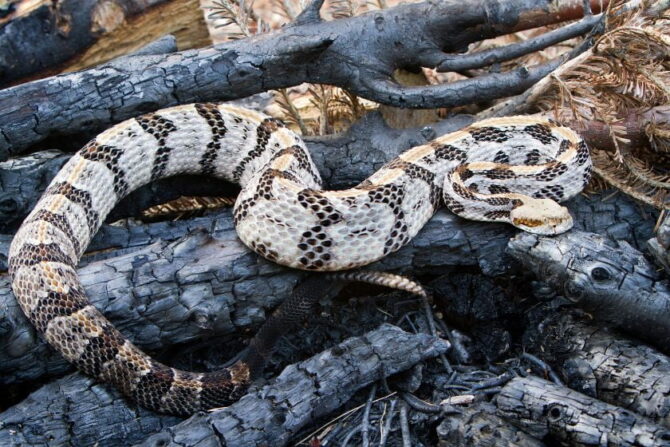
- Scientific name: Crotalus horridus
- Classification: Reptile
- Habitat: Mountainous forests, pine forests, swamps
- Diet: Carnivore
- Conservation status: Least Concern
The timber rattlesnake is found only on the eastern side of North America, and it is widely distributed in the United States.
This is a pit viper, and as such, it is highly venomous. The timber rattlesnake aligns with other snakes on this list as reptiles you should avoid provoking.
The timber rattlesnake’s venom can be fatal, with symptoms like nausea, vomiting, severe pain, blurry vision, and heart issues.
Bites from the timber rattlesnake are rare, however, which suggests that it is not aggressive.
15. Cottonmouth

- Scientific name: Agkistrodon piscivorus
- Classification: Reptile
- Habitat: Marshes, creeks, swamps
- Diet: Carnivore
- Conservation status: Least Concern
The cottonmouth is yet another snake that can be found in Georgia, and it is a scary one.
This snake can be found in both water and land, and its preferred habitat is an environment with water close by.
The cottonmouth can also be called the water moccasin, the black moccasin, the swamp moccasin, or the viper.
A bite from the cottonmouth is serious, and though actual deaths are rare, the cottonmouth’s venom can lead to amputation.
Symptoms include swelling and pain.
Georgia Wildlife Safety Tips
Georgia’s environment is an excellent place for humans and animals to interact, and this can either be good or bad news depending on how well the interactions go.
Whatever your reasons are for going to Georgia, you’d need some safety tips for getting along with the animals there.
Here they are:
- Animals should never be fed, whether they’re dangerous or not. This is especially true for the red fox because feeding one will attract others. Let the animals locate food on their own.
- Get rid of anything that could attract an animal to you. Food is the best example, and if you plan camping, ensure there’s no food close to the campground.
- Many animals are wary of humans, and you can use that to your advantage by making loud noises to chase the animal away. This works well for a lot of the dangerous animals on our list.
- Wear strong footwear when exploring the forest or anywhere close to water. That way, you won’t get bit if you accidentally step on a snake.
- Be cautious of where you sit or put your hand. Spiders, centipedes, and other smaller animals are not easily seen.
Frequently Asked Questions
What are Georgia’s most dangerous animals?
Many animals should be avoided in Georgia because their encounter with humans is more negative than positive.
Georgia has venomous spiders, venomous snakes, centipedes, and predatory mammals like the grizzly bear.
What predators live in Georgia?
There are a lot of animals that live in Georgia, and while not all are considered highly dangerous, you should still be careful around them.
Predators include skunks, bobcats, foxes, bears, snakes, and coyotes.
What animal causes the most deaths in Georgia?
In Georgia, venomous snakes are held responsible for the highest number of animal-related deaths. These snakes include cottonmouths, copperheads, and rattlesnakes.
Conclusion
Georgia presents a lot of fun activities that both inhabitants and tourists can benefit from. This is good news whether you’re moving into the state or visiting.
Exploring the wildlife is one activity you can embark on, but not without adequate information.
With our list of dangerous animals in Georgia to avoid and the wildlife safety tips, you’re one step towards having a lovely trip.






